The state of global palliative care research: a bibliometric study
Mevhibe B Hocaoglu1,a, Grant Lewison2,b, Hamish Sharp2, Tania Pastrana3,c, Eve Namisango4,d, James Cleary5,e, Barbara Hasties6, Eric Kabisa7, Helena Musau8,f, Kathryn Spangenberg9,g, Paola Ruiz10, Zipporah Ali11,h, Mertixell Mallafre-Larrosa12,i, Alfredo Polo12,j, Julie Torode2,k, Ajay Aggarwal13,l and Richard Sullivan2,m
1Cicely Saunders Institute, King’s College London, London, UK
2King’s College London, Institute of Cancer Policy, Guy’s Hospital, London SE1 9RT, UK
3Department of Palliative Medicine, Medical Faculty RWTH Aachen University, Aachen, Germany
4African Palliative Care Association, Kampala, Uganda
5Supportive Oncology, Department of Medicine, Division of Hematology/Oncology, Indiana University School of Medicine, Indianapolis, IN, USA
6Team Humanity International, Amsterdam, The Netherlands
7Rwanda Palliative Care and Hospice Organisation (RPCHO), Kigali, Rwanda
8Kenyatta University Teaching Research and Referral Hospital, Nairobi, Kenya
9Komfo Anokye Teaching Hospital, Kumasi, Ghana
10La Asociación Cuidados Paliativos de Colombia ASOCUPAC, Bogotá, Colombia
11Kenya Hospices and Palliative Care association (KEHPCA), Nairobi, Kenya
12City Cancer Challenge, Geneva, Switzerland
13Health Services Research & Policy, London School of Hygiene & Tropical Medicine, London, UK
ahttps://orcid.org/0000-0003-1417-7117
bhttps://orcid.org/0000-0002-4493-1216
chttps://orcid.org/0000-0002-1294-9657
dhttps://orcid.org/0000-0001-5032-4714
ehttps://orcid.org/0000-0002-1337-8462
fhttps://orcid.org/0009-0003-4648-221X
ghttps://orcid.org/0000-0002-1022-576X
hhttps://orcid.org/0000-0003-3643-0304
ihttps://orcid.org/0000-0002-2351-4755
jhttps://orcid.org/0000-0001-9800-8067
khttps://orcid.org/0000-0002-9755-3968
lhttps://orcid.org/0000-0003-3157-7067
mhttps://orcid.org/0000-0002-6435-1825
Abstract
Background: Palliative care research (PCR) plays a critical role in improving the quality of life for patients with serious illness, yet its global distribution and focus areas remain uneven. Understanding the trends and impact of PCR over the past decade can inform future research priorities and policy development.
Methods: We conducted a bibliometric analysis of publications indexed in the Web of Science related to PCR between 2013 and 2022. Articles were identified using a comprehensive filter based on title keywords and specialist journals, and were further classified by research domain, disease area and study type.
Results: The volume of PCR publications has grown over the past decade, increasing from 0.29% of all biomedical research outputs in 2013–14 to 0.62% in 2021–22. Countries with the highest levels of PCR output—primarily European and Anglophone nations—also ranked highly on the Economist Intelligence Unit’s Quality of Death Index. Using eight different bibliometric indicators, we assessed the impact of countries’ PCR outputs; while rankings varied by metric, European countries such as the Netherlands, Belgium, the United Kingdom and Ireland consistently performed strongly. Cancer emerged as the dominant disease focus, although many studies also addressed co-morbid conditions including COVID-19 in recent years. A significant proportion of PCR also examined the impact of illness on patients’ families and caregivers.
Conclusion: The findings highlight cancer as a major area of focus and need within PCR. However, research outputs remain disproportionately concentrated in high-income countries, revealing a persistent gap in low- and middle-income settings.
Recommendations: To address the growing global burden of cancer and serious illness, palliative care should be integrated as a core component of national cancer control plans. This integration must be supported by a targeted research agenda that emphasises implementation and scaling of palliative care models, particularly in low- and middle-income countries. Policymakers and research funders should prioritise holistic, patient-centred approaches and ensure that impact measurement reflects meaningful outcomes for patients and families.
Keywords: palliative care, holistic care, global health, research productivity, citation impact
Correspondence to: Mevhibe B Hocaoglu and Grant Lewison
Email: Mevhibe.hocaoglu@kcl.ac.uk and grantlewison@aol.co.uk
Published: 10/07/2025
Received: 21/02/2025
Publication costs for this article were supported by ecancer (UK Charity number 1176307).
Copyright: © the authors; licensee ecancermedicalscience. This is an Open Access article distributed under the terms of the Creative Commons Attribution License (http://creativecommons.org/licenses/by/4.0), which permits unrestricted use, distribution, and reproduction in any medium, provided the original work is properly cited.
Introduction
Palliative care is intended to relieve the physical pain and mental distress associated with a severe illness without curative intent, and so to improve the patients’ quality of life. World Health Organisation has defined palliative care as ‘… an integrated approach that aims to improve the quality of life for patients—both adults and children—and their families facing the challenges associated with life-threatening illness. It focuses on the prevention and relief of suffering through early identification, thorough assessment, and effective management of pain and other physical, psychosocial or spiritual problems’ [1]. It is usually, but not always, provided for patients who are terminally ill, many with cancer [2]. Timely palliative care can be cost saving, improve quality of life and survival [3–7]. Research can identify more effective ways to treat patients and enhance the quality of life for those nearing the end of life [8]. It also encompasses areas such as patients’ preferences regarding advance care planning, their relationships with family members and the grieving process. In some countries, this research may include aspects related to assisted dying, where legally applicable. Palliative care is therefore a multidisciplinary field that spans both medical and sociological dimensions. Given the highly individual nature of patient needs, it is often described as holistic care and can be challenging to define in strictly clinical terms [9].
To date, bibliometric analysis has been applied to only a small proportion of palliative care studies—approximately 0.1%—highlighting an opportunity to further explore research trends and gaps within the field. The most recent one, by researchers in Taiwan [10], covered the period from 2001 to 2016 and also analysed the citations to the papers. However, their search strategy was very limited in scope and identified a small number of papers. Some 50%–60% of papers germane to palliative care were not picked up by their limited search strategy in comparison to the more advanced one used in this analysis. An earlier analysis spanning the 21 years from 1993 to 2013, also from Taiwanese researchers [11], identified many more papers in the Web of Science in and found a very rapid growth rate (13%) in the field across that time period. There have also been studies of research activity (bibliometric studies) in palliative care in the continents of Africa [12], Asia [13] and Latin America and the Caribbean [14] as well as commentary on the disparities in low- and middle-income countries (LMICs) contributions to palliative care research (PCR) [15]. The Cheong study [13] compared research outputs with the Economist Intelligence Unit’s (EIU) 2015 Quality of Death Index (QODI), [16] encompassing 40 countries only and found a good correlation (R = 0.85), but many Asian countries carried out little or no relevant research. The Rhee study [12] found very few PCR papers from Africa (n = 47) published between 2005 and 2016, which may have seriously under-estimated work in that continent, such as the rapid expansion of palliative care provision in South Africa and Uganda [17]. Moreover, this search only focused on palliative care papers describing the development of services rather than wider literature. These reports and the more recent Global Atlas of Palliative Care [18] paint a comprehensive picture of the current provision of palliative care in different countries and regions of the world but also the need for research to shape that care. The situation is certainly improving, but huge gaps remain especially in less-developed nations.
The EIU report takes a more detailed approach, dividing the QODI into five categories:
- The palliative and healthcare environment
- Human resources and the need for training
- The affordability of palliative care
- The quality of care and
- Community engagement
Several of these map onto the research portfolio, the subject of this paper, which has been divided into some 19 research domains (Table 1). These research domains have been derived from standard bibliometric ‘research’ headings that are part of standard MESH descriptors of published papers. These are broad topic headings that have been established and validated by bibliometric databases that describe the type of research domain to which the paper is primarily concerned. Seven of these are diseases or conditions from which patients receiving (or needing) palliative care may suffer, but the others relate to the training of healthcare workers or are sociological aspects such as the effects on the patients’ relatives and the costs of care.
In addition, research may also be an indicator of the progress of palliative care in a country [19, 20]. Research advances knowledge and evidence-based practices, informs clinical guidelines and policies that ensure patients receive consistent, high-quality care across various settings [21, 22]. PCR identifies best practices, effective interventions, captures the complexity of patients, symptoms and concerns, informing holistic and innovative care models that can improve patient outcomes [22]. PCR informs what is feasible, accessible and effective palliative care and how best to develop and implement the most relevant and sustainable services [23]. Research is key in generating evidence across settings on early and timely integration of palliative care in the treatment process, on how to customise referral criteria, leading to better symptom control, reduced hospitalisations and enhanced patient and family satisfaction on a global scale [24]. The Lancet Commission on Palliative Care and Pain Relief Report highlights the need for health systems research, specifically implementation research on lessons learned from country experiences on both successful and failed programs particularly those impacting high-risk populations such as victims of humanitarian emergencies, migrant communities and children [25].
Despite the growing importance of palliative care as a global health priority, there remains a limited understanding of the scope, distribution and thematic focus of PCR worldwide. Understanding key areas and trends in PCR is essential for guiding research and funding priorities [26], particularly to ensure that under-researched areas—such as paediatric palliative care—receive adequate attention and support [27]. However, few studies have systematically mapped this evolving research landscape.
This study addresses that gap by asking: ‘What are the global trends, thematic priorities, and geographical patterns in PCR over the last decade, and how can these insights inform future research, policy, and education?’ To answer this question, we conducted a bibliometric analysis of PCR publications indexed in the Web of Science from 2013 to 2022. Articles and reviews were identified using a comprehensive filter based on title keywords and specialist journals and further categorised by disease area and study type.
Bibliometric analysis offers a robust, data-driven approach to evaluate the volume, distribution and impact of research outputs across time and geography [28]. By identifying underrepresented topics and regions and mapping patterns of collaboration and authorship, it provides objective evidence that can inform strategic planning and advocacy efforts in palliative care.
Findings from this work have multiple applications. Insights into prevalent themes—such as pain management—can support the development of evidence-based health policies, help clarify implementation strategies and contribute to the standardisation and scaling of palliative care services to improve access and quality [29]. Furthermore, the analysis can inform the design of education and training programs, ensuring healthcare professionals are equipped with up-to-date knowledge and best practices [30–32].
Importantly, identifying regional contributions can foster international collaboration and knowledge exchange while also exposing disparities in research output that may guide global health policies toward more equitable access to palliative care [33]. These insights can help shape future research agendas [34], promoting interdisciplinary and patient-centred approaches that prioritise the quality of life.
Several different groups may benefit from the outcomes of this analysis. Policymakers can use the findings to allocate resources more effectively and to support service development in under-resourced areas. The results also provide an evidence base for the creation of prioritised research agendas at national, regional and global levels. Moreover, the study offers opportunities to promote new partnerships between high-performing and developing regions, fostering capacity-building through training and resource sharing. Ultimately, by identifying emerging research areas, gaps and global patterns, this bibliometric analysis contributes to the strategic development of more inclusive, accessible and high-quality palliative care systems worldwide.
Methodology
In carrying out a bibliometric study of PCR, we relied mainly on the titles of the papers in the Web of Science (WoS; © Clarivate Analytics), but also on a few specialist journals, the large majority of whose papers were deemed relevant to the subject.
We co-developed a filter (available upon request from the corresponding authors), containing 51 title words and phrases and 13 specialist palliative care journals, that was applied to the WoS for the 10 years, 2013–22. This used pre-existing palliative care search terms supplemented by expert input and iterative search processes to refine the search strategy. The bibliographic data from articles and reviews thus identified were downloaded to Excel files and processed by a special macro (computer program) to create a single spreadsheet. Several Boolean conditions were needed to limit the application of some words or phrases in the filter. For example, end of life appears in the title of numerous papers concerned with the scrappage of vehicles and solar panels, as well as in many medical papers, which would be relevant to palliative care. We calibrated the filter [35] with reference to papers with and without an appropriate address word such as hospice or palliative, and found the precision, p, to be 0.90 and the recall, r, to be 0.85. This means that the true number of palliative care papers would have been p/r = 1.064 times the apparent number. Subsequently, 17 papers were found to be about the euthanasia of farm animals and were removed. The total of 33,593 papers also included 807 papers published in print in 2023 that appeared in online versions of journals in the previous year. These were included in the analysis of research domains, but not in the yearly tally of papers from different countries.
Further macros enabled us to mark each paper with the fractional counts of each country represented among the addresses. For example, a paper with two addresses in France and one in the USA would be categorised as FR = 0.67, US = 0.33, but as FR = US = 1 on an integer count basis. Country PCR outputs for 2013–17 were plotted against the country Gross Domestic Product in 2015, and also against the EIU QODI for that year [16] in order to see if good practice in the provision of palliative care was correlated with the amount of research. We also compared PCR outputs with the countries’ biomedical research outputs [36] in the two five-year periods, 2013–17 and 2018–22. [Incidentally, these latter decreased in the last 2 years in most countries because of COVID-19, so that the 5-year totals also decreased].
We also marked each paper to show if it could be regarded as being within each one of some 19 different research domains. These were given short codes (four or five letters) for ease of reference, see Table 1. Their presence in a domain was determined from words in their titles. The fractional count of each of the leading 32 countries in each domain was marked, and their relative commitment to each domain (relative to their presence in PCR) was then calculated as a decimal, greater or smaller than unity.
We wished to compare the countries based on the impact or utility of their PCR outputs. For this purpose, we used five different indicators commonly used in bibliometric analysis:
- The citation impact factor of the journals (JIF) in which their papers were published. These factors have been determined for most of the journals (but not all) and published by Clarivate Analytics. Although they are an imperfect measure of influence, they do correlate quite well with other measures such as a mean citation score in a fixed time window (we used 5 years). We called this Actual Citation Impact, ACI.
- The geometric mean is a better measure than the arithmetic mean because the distribution of citation numbers is unusual statistically, with a few papers receiving very high numbers of cites (several hundred) but most, fewer than ten. This can be calculated if unity is added to each citation score, the natural logarithm is taken, the mean for a group is then calculated and the result exponentiated and unity subtracted [37]. The resulting measure is typically half the arithmetic mean.
- The fractional count of the number of papers whose citation score is greater than the number needed to put them in the top-cited 5% of all PCR papers in 2013–18, which was 38. In fact, 814 papers or 5.023% achieved this score as citations are integers. The resulting percentage, divided by 0.05023, was called World Scale (WS) by analogy with world oil tanker charter rates [38].
- The percentage of reviews, as classified by the WoS; a mark of esteem in which the country’s authors are held by journal editors as these documents are usually commissioned by them from leading experts in the subject [39].
- A relatively new measure, the mean number of downloads of PCR papers since 2013. Since this obviously decreases for more recent papers (there has been less time for them to be downloaded), the mean score for each country and year was normalised with respect to the mean for the world total. This decreased from 16.0 for 2013 papers to 5.0 for ones published in 2022 [40, 41].
Because international papers tend to be more frequently cited than domestic ones for a given country, and their mean citation score is likely to be affected by the prowess of their foreign partners, we also calculated this for the leading countries’ domestic papers as an alternative indicator. We made this distinction for the indicators based on JIF, on ACI and on downloads, so making eight in total. This approach provides a very comprehensive comparison of the quality of the PCR of the leading countries in addition to simpler metrics of impact, e.g., output relative to a country’s wealth.
Results
In the 10-year study period, there were 32,786 published PCR papers, which represented only 0.4% of all biomedical research during those years. However, this percentage rose from 0.3% in the first 6 years to attain 0.6% in 2022, when overall biomedical output was declining, probably because of the effects of COVID-19. Countries varied greatly in their relative commitment to PCR, see Figure 1a and b. Ireland (IE), Australia (AU) and New Zealand (NZ) showed the highest value, and the first two, with Singapore (SG), all published more than 0.8% of their biomedical research outputs on PCR in 2018–22. At the other extreme, in addition to countries with no publications, four Asian countries China (CN, 0.09%), Iran (IR, 0.16%), India (IN, 0.18%) and Türkiye (TR, 0.21%) all published much less PCR than the world mean over the 10 years.
Table 1. Nineteen research domains within PCR linked to oncology and codes.
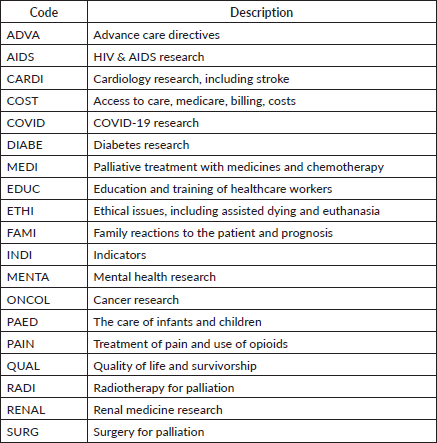
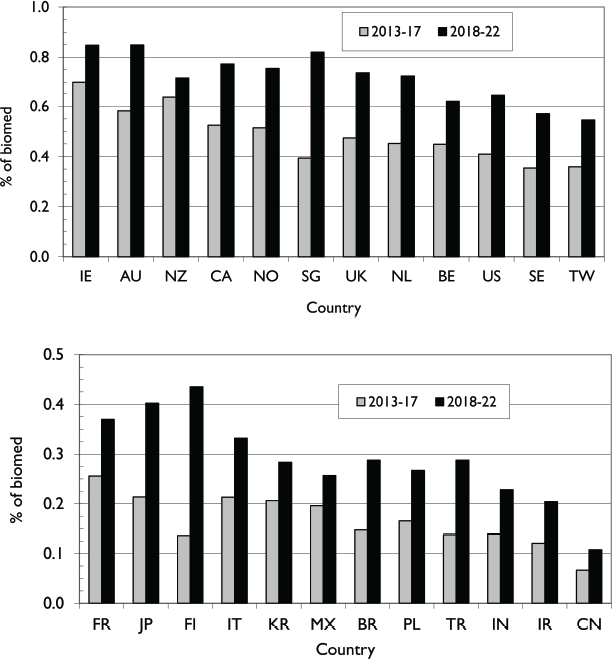
Figure 1. (a): The percentage of biomedical research attributable to PCR from 12 leading countries in two five-year periods: highest percentages. IE = Ireland, AU = Australia, NZ = New Zealand, CA = Canada, NO = Norway, SG = Singapore, NL = Netherlands, BE = Belgium, SE = Sweden, TW = Taiwan. (b): The percentage of biomedical research attributable to PCR from 12 leading countries in two five-year periods: lowest percentages. FR = France, JP = Japan, FI = Finland, IT = Italy, KR = South Korea, MX = Mexico, BR = Brazil, PL = Poland, TR = Türkiye, IN = India, IR = Iran, CN = China.
Some countries made big increases in their PCR publication share, notably Singapore, the Netherlands (NL) and the United States among those with the highest relative commitments, and Finland (FI), Brazil (BR) and Türkiye among the laggards. As expected, the amount of PCR in 2013–17 from the different countries correlated much better with GDP in 2015 (r2 = 0.73) than with population (r2 = 0.19). The graph with GDP (Figure 2) shows that China (CN) and Mexico (MX) are by far the lowest performers.
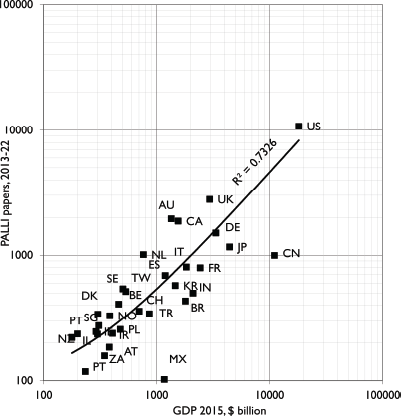
Figure 2. Plot of PCR outputs in 2013–17 for leading countries against their Gross Domestic Product in 2015 (World Bank data). Digraph codes as in Figure 1a and b; Also AT = Austria, CH = Switzerland, DE = Germany, DK = Denmark, ES = Spain, IL = Israel, PT = Portugal, ZA= South Africa.
We then investigated whether the amount of PCR correlated with the ‘QODI’. This is shown in Figure 3. The correlation is strongly positive. The two main outliers in Figure 2, China and Mexico, have spots that are now close to the best-fit curve. The new outliers are Finland (FI), which did relatively little PCR compared with its QODI ranking but substantially increased it in 2018–22, see Figure 1b, and Ireland (IE) and New Zealand (NZ), which perhaps devoted more effort to PCR than was needed. However, our selection of countries excludes, for example, Uganda, a low-income country that ranked well in the QODI and above India a low-middle and just below Brazil an upper–middle income country.
The division of PCR into the disease domains was dominated by cancer research (29.7%), followed by mental disorders (8.2%), cardiovascular research (3.5%) and renal medicine (3.1%). However, in the last 3 years (2020–22), research on these last two disease areas was overtaken by research on patients with COVID-19. AIDS as a disease area attracted very little PCR except in South Africa (ZA), where the relative commitment was over 16 times the world norm, and the USA. Diabetes only led to 0.3% of PCR.
Of the other research domains listed in Table 1, the most popular was the effects on family members and friends, with 13.5% of the PCR total. Other domains were research on children (7.3%), which was very similar to the proportion of people needing palliative care each year (about 57 million) who were children (7% at least) [17]. Dealing with pain and concern with quality of life each attracted 4.6% of the total, followed by ethical considerations (3.4%) and the education and training of healthcare workers (3.0%). Since the QODI allocated one fifth of its score to this category, this seems to be unduly low. There was also very little PCR on the costs of treatment. Since the QODI report noted that more attention to the provision of palliative care could lead to greater savings elsewhere in a country’s health service costs, this also seems to be a notable omission.
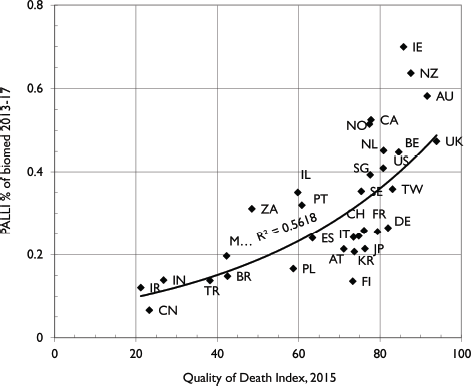
Figure 3. Comparison of the amount of PCR relative to the total biomedical research in 2013–17 of leading countries with the EIU QODI for 2015.
The last three research domains were the three main treatment methods: use of medicines (5.2%), radiotherapy (2.7%) and surgery (2.2%). Over 500 papers simply referred to ‘chemotherapy’, but most papers on medicines mentioned one or more individually named products. The ones most commonly listed were methadone (n = 48 papers, 0.14%), paclitaxel (n = 23) and cisplatin (n = 20).
Tables 2 and 3 show the relative commitment of the 32 leading countries to each of the research domains in PCR. Their outputs are fractionated, and the values are presented relative to unity, which is the world value. Values over 4 are in cells tinted dark green, over 2 in cells tinted mid-green, over 1.414 (=√2) tinted pale green, below 0.707 (=1/√2) tinted pale yellow, below 0.5 tinted light brown and equal to zero tinted pink. For the larger countries scientifically, the values depart less from unity but there are some interesting exceptions. Thus, the USA has a big PCR effort on AIDS, where the disease first drew major attention, but much less on diabetes as a cause of the need for palliative care. The latter occasioned more PCR in Taiwan (TW), and in Singapore (SG), Australia (AU) and China (CN). PCR for cancer was actively pursued in East Asian countries such as Japan (JP), South Korea (KR), China (CN) and Taiwan (TW).
Of the other research domains, PCR on the effects on family members is most notable in the three Scandinavian countries but not Finland (FI), although it increased its output markedly in the later quinquennium. The use of medicines in palliative care was researched particularly in the east Asian countries (Japan (JP), South Korea (KR) and China (CN)), but not Taiwan (TW) and definitely not Singapore (SG). These three countries also researched the use of palliative radiotherapy and surgery. Belgium (BE) had much the highest relative commitment to ethical issues, followed by the Netherlands (NL) and Spain (ES). Almost all the primarily Belgian papers in this domain were about euthanasia, which was legalised in 2002, even for children of all ages, and de-criminalised assisted dying, but had some definitional problems [42]. Belgium, with the Netherlands, also did relatively the most research on advanced directives (ADVA), which can prescribe the limits on treatment of a patient who may be unable to speak. In view of the lack of research attention to the training of healthcare workers, there are exceptions in Ireland (IE) and Finland (FI). These papers cover many levels of personnel from doctors and nurses to pharmacists and nursing home health-care assistants.
Table 2. Relative commitment of 32 leading countries to disease domains within PCR. Domain codes are in Table 1; country codes are below Figures 2a,b and 3.
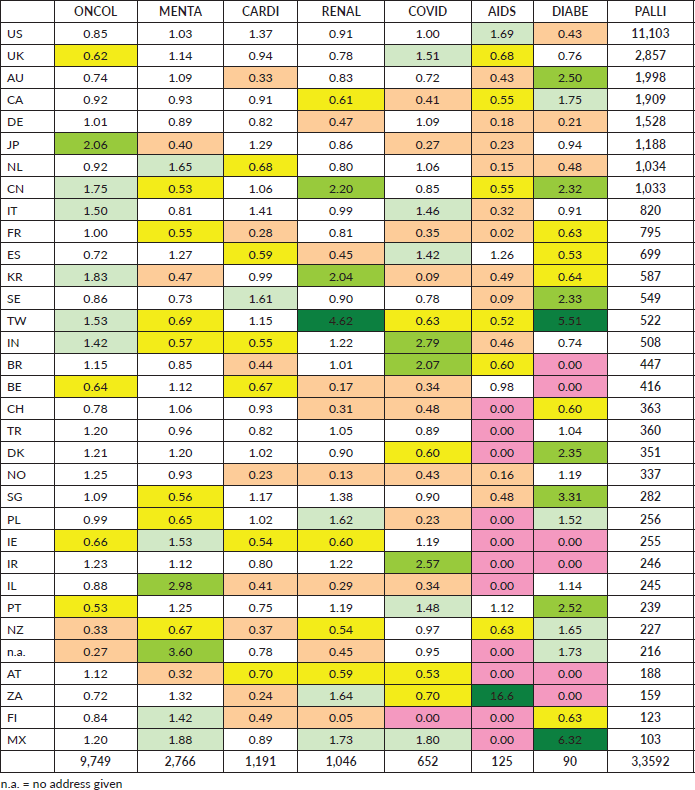
Table 3. Relative commitment of 32 leading countries to all other domains within PCR. Domain codes are in Table 1; country codes are below Figures 2a, b and 3 and listed in the same order as Table 2.
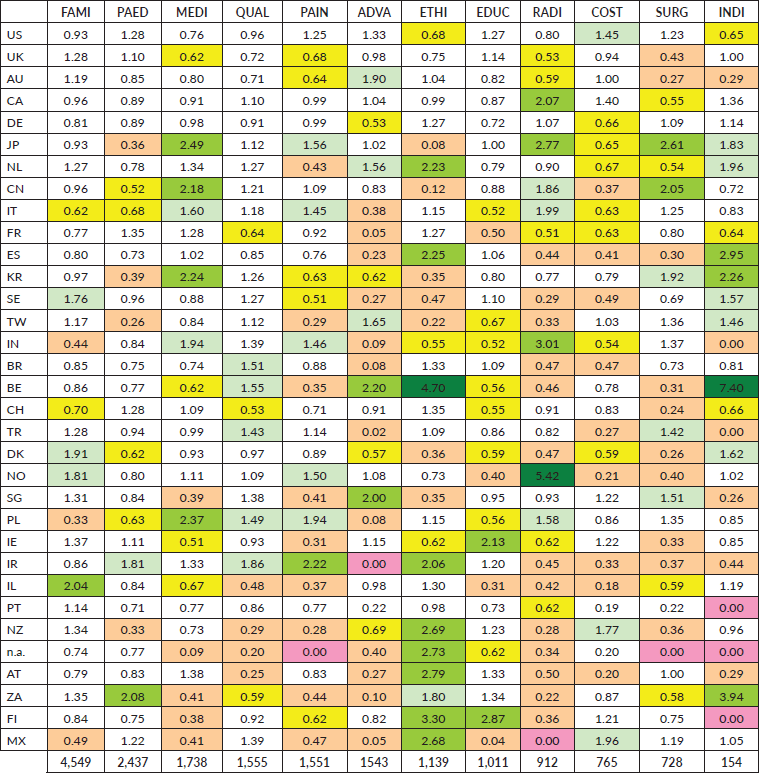
We turn next to the measures of the impact of PCR. Table 4 gives the actual values of the different parameters, except for the downloads, which are the ratio of the numbers for individual papers to the mean for the world in that year and so are relative to unity. The ranking of the leading 32 countries on each of the eight parameters, and overall, is shown in Table 5. It is striking that there is considerable divergence between these rankings. For example, the Netherlands (NL) and Belgium (BE), which clearly rank at the top, do not score highly for the percentage of reviews (% rev.). On the other hand, Ireland (IE), which ranks first for the percentage of reviews and for its WS value, only published its papers in low-impact factor journals. China’s (CN) papers were the most downloaded by a large margin but were in less-cited journals and were not well cited. However, this high ranking meant that the overall rank of China was much higher than that of most other Asian countries. The ranking of countries’ domestic papers often differed markedly from that of all their papers. Thus, the UK ranked much higher on JIF and ACI for its domestic papers, but Switzerland (CH) showed the reverse. However, the ranking of downloads (for which r2 = 0.88) altered relatively much less than for JIF (r2 = 0.17) and for ACI (r2 = 0.46).
Table 4. Impact parameters for PCR papers, 2013–22, for the 32 leading countries.
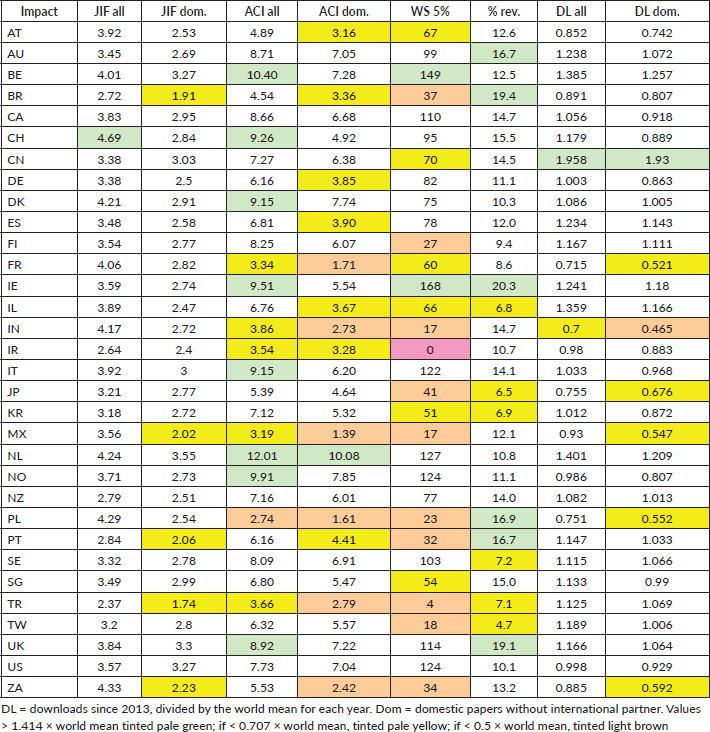
Table 5. Ranking of 32 leading countries in PCR impacts according to the above table for each of eight parameters and overall (right-hand column).
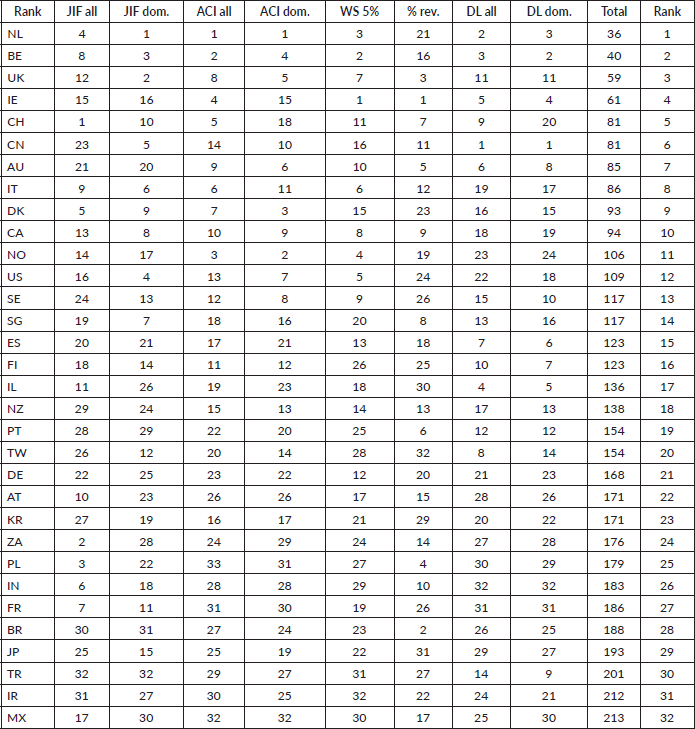
A similar analysis was performed on the PCR papers in the 19 different domains and the results are shown in Table 6. The two formats (actual values and rankings) have been shown in the left and right tables, respectively, with similar cell tinting as in Table 4.
Table 6. Impact parameters (left table) for PCR papers, 2013–22, in 19 research domains and ranking of the domains (right table).
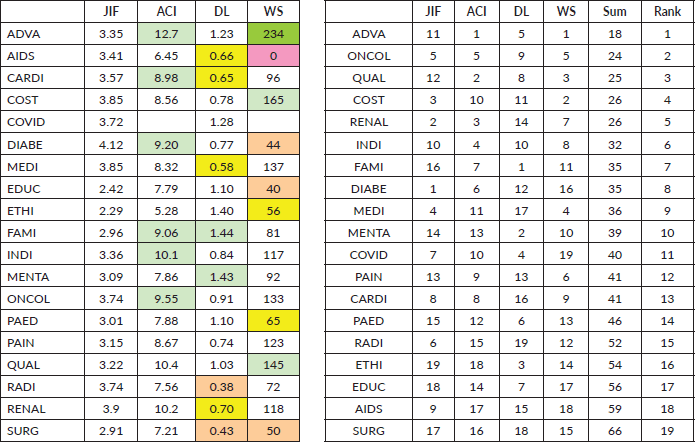
Because none of the papers on COVID-19 had citation scores, a mean rank of 10 was added to their rank on the three other parameters so that their impact could be compared with the papers in the other domains. It appeared that papers on ADVA and on cancer (ONCOL) had the greatest influence. Papers on the training and education of healthcare personnel (EDUC) ranked poorly, which may be discouraging for work on this subject which is important for the overall ranking of countries as providers of a good death.
Discussion
Annually, around 60 million people experience serious health-related suffering that affects physical, social, spiritual and emotional well-being and requires professional intervention [26]. This trend is expected to continue for several decades, mainly affecting LMICs due to a disproportionate rise in rates of cancer, cerebrovascular disease, lung disease and dementia [43]. Despite the increasing need, palliative care, and the associated research, continue to be relatively neglected areas of medicine, especially in less-developed countries [44]. Whilst the PCR share of all biomedical research more than doubled between 2013 and 17, the overall levels of research remain well below what is needed to address the global burden.
While countries such as Ireland, Australia, and Singapore have demonstrated increased activity in PCR, others—including China, Iran and India—show comparatively lower levels of research output within the period analysed. The relationship between healthcare spending and the economic performance of countries is stable over time with occasional sudden changes and breaks in their trends [45]. Clark et al [46] observed moderate to strong associations between indicators of national development, including the percentage of a country’s GDP spent on public health expenditure, corruption, and weak governance, with the level of palliative care development. Our findings align with these observations, where countries with higher GDPs generally produced more PCR. This indicates that economic resources significantly influence research capacity in PCR, with China and Mexico notably underperforming relative to their GDPs. Other factors such as the relative level of development of palliative care may also play a role in PCR; for example, Mexico is at an early stage of ‘isolated provision’, characterised by limited support for activism, donor-dependent funding, scarce morphine availability and small-scale service provision [47].
Our findings correlate surprisingly well with the QODI. There is, however, remarkable heterogeneity around the quality of PCR on a country-by-country basis. The positive correlation between PCR and the QODI further validates the importance of PCR in enhancing the quality of end-of-life care. Outliers such as Finland, which showed less PCR relative to its QODI ranking but increased its output substantially in recent years, indicate potential areas for strategic research investment. Conversely, countries like Ireland and New Zealand, with higher PCR than their QODI might suggest a strong commitment that perhaps exceeds immediate national needs. Both Ireland and New Zealand have palliative care services at an advanced stage of integration to mainstream healthcare services, with widespread palliative care activism, comprehensive service provision, broad awareness and an updated strategy [47].
Cancer research leads PCR, followed by mental disorders, cardiovascular diseases and renal medicine. This is not unexpected as cancer poses a significant burden in both high-income countries and emerging economies [47–50]. Life-limiting illnesses vary significantly across different regions due to varying prevalence of specific diseases and health conditions. Approaches to palliative care—and by extension, PCR—vary significantly across countries, often reflecting national disease burdens and healthcare priorities. In high-income countries, non-communicable diseases such as cancer, cardiovascular diseases and dementia are predominant causes of life-limiting conditions [48]. In LMICs, communicable diseases like HIV/AIDS and tuberculosis are more prevalent, although non-communicable diseases are also on the rise [51] and projections estimate that by the year 2040 as much as 70%–75% of cancer mortality will be in LMICs [22]. This divergence in clinical focus may influence the nature and scope of research activity across regions. For instance, in settings where palliative care is still primarily associated with cancer, research into other domains may be under-prioritised. Our findings also highlight the variability in PCR focus across countries and therefore relative readiness to respond to this growing need for cancer-related palliative care services. Notably, South Africa and the USA had a higher relative commitment to AIDS-related palliative care, reflecting regional disease burdens and healthcare priorities. In contrast, East Asian countries like Japan, South Korea and China focus more on palliative care related to cancer and the use of medicines. Belgium and the Netherlands show a strong emphasis on ethical issues, particularly euthanasia, aligning with their progressive healthcare policies. Scandinavian countries, excluding Finland, lead in research on the effects of palliative care on family members, while Ireland and Finland show notable attention to the training of healthcare workers. Our analysis also reveals that countries like the Netherlands and Belgium, despite not publishing extensively in journals with high JIF values, achieve high citation metrics, indicating influential research. Ireland’s high ranking in review publications suggests a leadership role in synthesising and guiding PCR knowledge. Meanwhile, China’s high download rates reflect substantial global interest in its PCR outputs, although its citation metrics indicate room for quality improvement. These findings highlight the varied national priorities, capacity and potential areas for international leadership, collaboration and knowledge sharing. These include the evidence of performance, outcomes and cost-effectiveness of innovative models of care to shape and drive scale-up of these critical services especially in LMICs with equity of access, integrated models of care and quality of services in focus.
Conclusion
This comprehensive analysis presents the evolving landscape of PCR and its critical role in global healthcare. The disparities in national research output and focus areas reveal opportunities for targeted investments and international collaboration. As the demand for high-quality palliative care continues to grow, especially in the wake of global health challenges such as COVID-19 and cancer, fostering a balanced and comprehensive approach to PCR is essential. There remain huge gaps in research into critical domains that will inform national policy such as service delivery models in LMICs and quality improvement of these services. Countries must not only increase their research output but also ensure alignment with global best practices and healthcare needs to improve the quality of life for patients with advanced and life-limiting illness. Addressing the identified gaps and disparities is crucial for improving the quality of palliative care worldwide, ensuring that research efforts are more equitably distributed and aligned with the diverse needs of different populations.
Acknowledgments
MBH is supported by the National Institute of Health and Social Care Research Applied Research Collaboration South London.
Conflicts of interest
None.
Funding
This research was conducted as a contribution to a research partnership between Institute of Cancer Policy, King’s College London UK and City Cancer Challenge Foundation, Geneva, Switzerland. The work was supported by an unrestricted research grant to City Cancer Challenge Foundation by the BMS Foundation.
Consent for publication
Not applicable.
Ethics approval and consent to participate
Not applicable.
Author contributions
Study conception and design: MBH, GL, RS. MBH is the lead of the study and JT the coordinator. Analysis and interpretation of results: ALL carried out the first analysis, ALL contributed to further interpretation. Draft manuscript preparation: RS and MBH drafted the first draft of the paper. ALL provided critical feedback. ALL reviewed the results and approved the final version of the manuscript.
Availability of data and materials
Requests for relevant codes and other relevant materials for search can be made through the corresponding author. This request will be reviewed by the principal investigator (RS).
References
1. World Health Organization (2014) Strengthening of Palliative Care as a Component of Comprehensive Care Throughout the Life Course. Sixty-seventh World Health Assembly (Geneva: World Health Organization) pp: 9–14
2. Horton R (2018) A milestone for palliative care and pain relief Lancet 391(10128) 1338–1339 https://doi.org/10.1016/S0140-6736(17)32560-6
3. Temel JS, Greer JA, and Muzikansky A, et al (2010) Early palliative care for patients with metastatic non–small-cell lung cancer N Engl J Med 363(8) 733–742 https://doi.org/10.1056/NEJMoa1000678 PMID: 20818875
4. Bakitas M, Lyons KD, and Hegel MT, et al (2009) Effects of a palliative care intervention on clinical outcomes in patients with advanced cancer: the project ENABLE II randomized controlled trial JAMA 302(7) 741–749 https://doi.org/10.1001/jama.2009.1198 PMID: 19690306 PMCID: 3657724
5. Connor SR, Pyenson B, and Fitch K, et al (2007) Comparing hospice and nonhospice patient survival among patients who die within a three-year window J Pain Sympt Manage 33(3) 238–246 https://doi.org/10.1016/j.jpainsymman.2006.10.010
6. Zimmermann C, Swami N, and Krzyzanowska M, et al (2014) Early palliative care for patients with advanced cancer: a cluster-randomised controlled trial The Lancet 383(9930) 1721–1730 https://doi.org/10.1016/S0140-6736(13)62416-2
7. Groenvold M, Petersen MA, and Damkier A, et al (2017) Randomised clinical trial of early specialist palliative care plus standard care versus standard care alone in patients with advanced cancer: the Danish Palliative Care Trial Palliat Med 31(9) 814–824 https://doi.org/10.1177/0269216317705100 PMID: 28494643
8. Kaasa S and De Conno F (2001) Palliative care research Eur J Cancer 37 153–159 https://doi.org/10.1016/S0959-8049(01)00260-X
9. Kaasa S and Radbruch L (2008) Palliative care research–priorities and the way forward Eur J Cancer 44(8) 1175–1179 https://doi.org/10.1016/j.ejca.2008.02.036 PMID: 18374560
10. Liu C-J, Yeh T-C, and Hsu S-H, et al (2018) Bibliometric analysis of palliative care-related publication trends during 2001 to 2016 Am J Hospice Palliat Med 35(10) 1280–1286 https://doi.org/10.1177/1049909118773751
11. Chang H-T, Lin M-H, and Chen C-K, et al (2016) Hospice palliative care article publications: An analysis of the Web of Science database from 1993 to 2013 J Chin Med Assoc 79(1) 29–33 https://doi.org/10.1016/j.jcma.2015.05.012
12. Rhee JY, Garralda E, and Torrado C, et al (2017) Palliative care in Africa: a scoping review from 2005–16 Lancet Oncol 18(9) e522-e31 https://doi.org/10.1016/S1470-2045(17)30420-5 PMID: 28884701
13. Cheong WL, Mohan D, and Warren N, et al (2019) Palliative care research in the Asia Pacific region: a systematic review and bibliometric analysis of peer-reviewed publications J Palliat Med 22(5) 545–552 https://doi.org/10.1089/jpm.2018.0447
14. Pastrana T, De Lima L, and Eisenchlas J, et al (2012) Palliative care research in Latin America and the Caribbean: from the beginning to the Declaration of Venice and beyond J Palliat Med 15(3) 352–358 https://doi.org/10.1089/jpm.2011.0429 PMID: 22401357
15. Pastrana T, Vallath N, and Mastrojohn J, et al (2010) Disparities in the contribution of low- and middle-income countries to palliative care research J Pain Symptom Manage 39(1) 54–68 https://doi.org/10.1016/j.jpainsymman.2009.05.023
16. Economist Intelligence Unit (2015) The 2015 Quality of Death Index: Ranking Palliative Care Across the World (London: The Economist Intelligence Unit) p: 15.
17. Suresh T, Abarshi E, and Pastrana T, et al (2015) The 2015 Quality of Death Index: Ranking Palliative Care Across The World (London: The Economist Intelligence Unit Ltd)
18. Worldwide Hospice Palliative Care Alliance. Global atlas of palliative care 2020.
19. Alsirafy SA and Mousa SM (2022) Palliative care journal publications by country as a metric for palliative care development level BMJ Support Palliat Care 14(e3) e2686-e2693 PMID: 36130815
20. Rhee JY, Garralda E, and Torrado C, et al (2017) Publications on palliative care development can be used as an indicator of palliative care development in Africa J Palliat Med 20(12) 1372–1377 https://doi.org/10.1089/jpm.2017.0168 PMID: 28661713
21. Abernethy AP, Aziz NM, and Basch E, et al (2010) A strategy to advance the evidence base in palliative medicine: formation of a palliative care research cooperative group J Palliat Med 13(12) 1407–1413 https://doi.org/10.1089/jpm.2010.0261 PMID: 21105763 PMCID: 3876423
22. Harding R and Higginson IJ (2010) PRISMA: a pan-European co-ordinating action to advance the science in end-of-life cancer care Eur J Cancer 46(9) 1493–1501 https://doi.org/10.1016/j.ejca.2010.01.035 PMID: 20185295
23. Harding R and Higginson IJ (2005) Palliative care in sub-Saharan Africa Lancet 365(9475) 1971–1977 https://doi.org/10.1016/S0140-6736(05)66666-4 PMID: 15936427
24. Hui D, Heung Y, and Bruera E (2022) Timely palliative care: personalizing the process of referral Cancers 14(4) 1047 https://doi.org/10.3390/cancers14041047 PMID: 35205793 PMCID: 8870673
25. Knaul FM, Farmer PE, and Krakauer EL, et al (2018) Alleviating the access abyss in palliative care and pain relief-an imperative of universal health coverage: the Lancet Commission report Lancet 391(10128) 1391–1454 https://doi.org/10.1016/S0140-6736(17)32513-8
26. Sigurdardottir KR, Haugen DF, and van der Rijt CC, et al (2010) Clinical priorities, barriers and solutions in end-of-life cancer care research across Europe. Report from a workshop Eur J Cancer 46(10) 1815–1822 https://doi.org/10.1016/j.ejca.2010.03.012 PMID: 20456947
27. Crooks J, Carduff E, and Hudson B, et al (2023) P-109 Research addressing the priorities of patients, carers and health and social care professionals: an updated grant mapping analysis of top palliative and end of life care research funders BMJ Support Palliat Care 13(Suppl 5) A50
28. Van Leeuwen T, Visser M, and Moed H, et al (2003) The Holy Grail of science policy: Exploring and combining bibliometric tools in search of scientific excellence Scientometrics 57(2) 257–280 https://doi.org/10.1023/A:1024141819302
29. Sleeman KE, Timms A, and Gillam J, et al (2021) Priorities and opportunities for palliative and end of life care in United Kingdom health policies: a national documentary analysis BMC Palliative Care 20(1) 108 https://doi.org/10.1186/s12904-021-00802-6 PMID: 34261478 PMCID: 8279030
30. Chen X, Zou D, and Xie H, et al (2021) Past, present, and future of smart learning: a topic-based bibliometric analysis Int J Educ Technol High Educ 18(1) 2 https://doi.org/10.1186/s41239-020-00239-6
31. Gao Y, Wong SL, and Md. Khambari MN, et al (2022) A bibliometric analysis of online faculty professional development in higher education Res Pract Technol Enhanced Learn 17(1) 17 https://doi.org/10.1186/s41039-022-00196-w
32. Kokol P, Blažun Vošner H, and Završnik J (2021) Application of bibliometrics in medicine: a historical bibliometrics analysis Health Inf Lib J 38(2) 125–138 https://doi.org/10.1111/hir.12295
33. Viergever RF and Hendriks TCC (2016) The 10 largest public and philanthropic funders of health research in the world: what they fund and how they distribute their funds Health Res Policy Syst 14(1) 12 https://doi.org/10.1186/s12961-015-0074-z PMID: 26892771 PMCID: 4759950
34. European Research Council (2013) European Research Council Workshop: Monitoring The Performance and Quality of Peer Review Systems 2013 [https://erc.europa.eu/event/european-research-council-workshop-monitoring-performance-and-quality-peer-review-systems]
35. Lewison G (1996) The definition of biomedical research subfields with title keywords and application to the analysis of research outputs Res Eval 6(1) 25–36. https://doi.org/10.1093/rev/6.1.25
36. Lewison G and Paraje G (2004) The classification of biomedical journals by research level Scientometrics 60 145–157 https://doi.org/10.1023/B:SCIE.0000027677.79173.b8
37. Thelwall M (2016) The precision of the arithmetic mean, geometric mean and percentiles for citation data: an experimental simulation modelling approach J Inform 10(1) 110–123 https://doi.org/10.1016/j.joi.2015.12.001
38. Lewison G, Thornicroft G, and Szmukler G, et al (2007) Fair assessment of the merits of psychiatric research Br J Psychiatry 190(4) 314–318 https://doi.org/10.1192/bjp.bp.106.024919 PMID: 17401037
39. Lewison G (2009) The percentage of reviews in research output: a simple measure of research esteem Res Eval 18(1) 25–37 https://doi.org/10.3152/095820209X410406
40. Pinkowitz L (2002) Research dissemination and impact: evidence from Web site downloads J Finance 57(1) 485–499 https://doi.org/10.1111/1540-6261.00429
41. Garcia-Dorado D, Schlūter KD, and Martinson EA, et al (2005) Which papers are most interesting to the readers of cardiovascular research? Information from download monitoring Cardiovasc Res 65(1) 1–5
42. Van Zeebroeck S (2018) Kill first, ask questions later: the rule of law and the Belgian Euthanasia Act of 2002 Statute Law Rev 39(3) 244–257 https://doi.org/10.1093/slr/hmx007
43. Sleeman KE, de Brito M, and Etkind S, et al (2019) The escalating global burden of serious health-related suffering: projections to 2060 by world regions, age groups, and health conditions Lancet Glob Health 7(7) e883–e92 https://doi.org/10.1016/S2214-109X(19)30172-X PMID: 31129125 PMCID: 6560023
44. Gelfman LP, Meier DE, and Morrison RS. (2008) Does palliative care improve quality? A survey of bereaved family members J Pain Symptom Manage 36(1) 22–28 https://doi.org/10.1016/j.jpainsymman.2007.09.008 PMID: 18411019 PMCID: 2527760
45. Carrion-i-Silvestre JL (2005) Health care expenditure and GDP: Are they broken stationary? J Health Econ 24(5) 839–854 https://doi.org/10.1016/j.jhealeco.2005.01.001 PMID: 16129126
46. Clark J, Barnes A, and Campbell M, et al (2019) A life or “Good Death” situation? a worldwide ecological study of the national contexts of countries that have and have not implemented palliative care J Pain Sympt Manage 57(4) 793–801 e11 https://doi.org/10.1016/j.jpainsymman.2018.12.007
47. Clark D, Baur N, and Clelland D, et al (2020) Mapping levels of palliative care development in 198 countries: the situation in 2017 J Pain Symptom Manage 59(4) 794–807 e4 https://doi.org/10.1016/j.jpainsymman.2019.11.009 PMCID: 7105817
48. Regional Office for the Americas of the World Health Organization (2024) Noncommunicable Diseases (Geneva: World Health Organization)
49. Mahase E (2019) Cancer overtakes CVD to become leading cause of death in high income countries BMJ 366 l5368 https://doi.org/10.1136/bmj.l5368 PMID: 31481521
50. Bidoli E, Lamaj E, and Angelin T, et al (2021) Linearity of age at cancer onset worldwide: 25-year population-based cancer registry study Cancers (Basel) 13(21) 5589 https://doi.org/10.3390/cancers13215589 PMID: 34771751 PMCID: 8583131
51. Jaspers L, Colpani V, and Chaker L, et al (2015) The global impact of non-communicable diseases on households and impoverishment: a systematic review Eur J Epidemiol 30 163–188 https://doi.org/10.1007/s10654-014-9983-3






